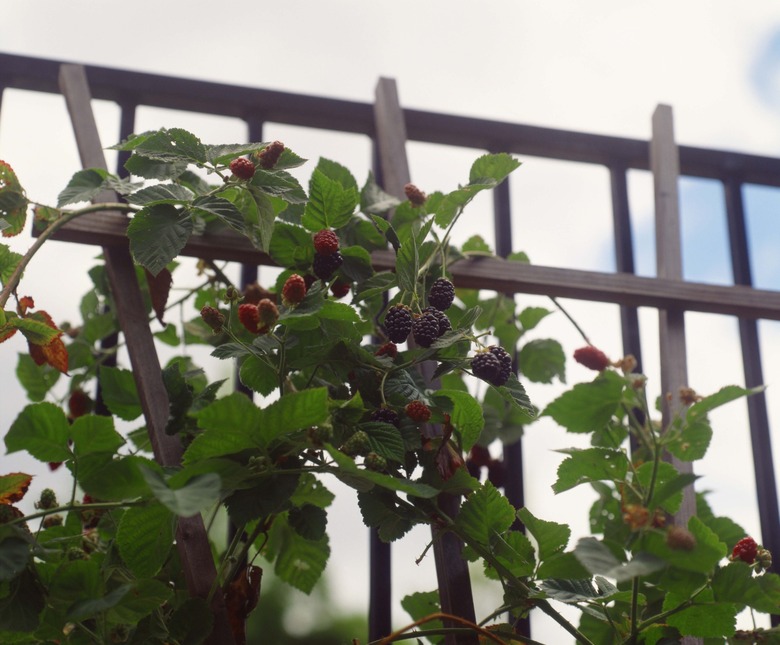How To Prune A Black Satin Blackberry
With no thorns to punish gardeners who can't resist temptation, getting caught red-handed is inevitable when sampling juicy "Black Satin" blackberries (Rubus subgenus Rubus Watson "Black Satin") fresh from the cane. "Black Satin" is a semi-erect thornless blackberry that's hardy in U.S. Department of Agriculture plant hardiness zones 5 through 8 and bears soft pink spring blooms followed by prolific deep blue-black midsummer berries. Prune "Black Satin" annually in summer and winter for healthy, productive canes.
Step 1
Prune "Black Satin" the first year after planting to encourage it to develop a strong root system, vigorous canes and good fruit production. Blackberries produce fruit on 2-year-old canes. The first canes on thornless blackberries such as "Black Satin" often grow along the ground like a vine and develop poorly, so it's worth sacrificing the first year's crop to produce strong-growing plants in the long term. Prune canes on new plants to 3 or 4 inches in late winter to encourage stronger growth and a large crop of fruit in subsequent years.
Lean on Me
Step 1
As a semi-erect blackberry, "Black Satin" benefits from support on a blackberry trellis. Blackberry trellises are posts with wires fixed between them. They keep blackberry canes off the ground where they can root and spread, and they help keep fruit dry and reduce pest attack. Blackberry trellises also help gardeners separate first and second year canes and allow air circulation through plants, reducing disease. To create a trellis for a "Black Satin" blackberry, drive two posts into the ground 5 feet away on either side of the plant and fix two wires tightly between them, at 3 feet and 5 feet high.
Step 2
- Prune "Black Satin" the first year after planting to encourage it to develop a strong root system, vigorous canes and good fruit production.
- The first canes on thornless blackberries such as "Black Satin" often grow along the ground like a vine and develop poorly, so it's worth sacrificing the first year's crop to produce strong-growing plants in the long term.
Cruel to be Kind
Step 1
Annual "Black Satin" blackberry pruning involves removing old canes and tipping, or cutting the tops off, new canes and tying them to supporting wires in late summer, followed by pruning lateral canes in winter. Start by removing old canes as close to the ground as possible with pruning or lopping shears. These are the old, dry, woody canes that fruited this year. Train the new, green canes that grew this year along the top wire of the trellis, and tie them in at the top and bottom wires with string. Cut the tips off where they grow too long for the support wires. In winter, prune the lateral shoots, or the shoots that have grown from the sides of the new canes, to 12 to 14 inches.
Bringing in the Berries
Step 1
The amount of cane pruned away from a "Black Satin" blackberry affects the number of fruit produced on each shoot, but not the total harvest weight. Fumiomi Takeda and other researchers at the Appalachian Fruit Research Station removed lateral canes from plants so that three, six, nine or 12 canes were left to fruit the following year. They found that plants with three canes produced larger berries on each cane than plants with 12 canes, but that both plants produced the same amount of fruit overall. Gardeners can prune to three canes to make the crop easier to pick, or leave 12 lateral canes to save time spent pruning.
Step 2
- Annual "Black Satin" blackberry pruning involves removing old canes and tipping, or cutting the tops off, new canes and tying them to supporting wires in late summer, followed by pruning lateral canes in winter.
